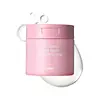What's inside
What's inside
 Key Ingredients
Key Ingredients

 Benefits
Benefits

 Concerns
Concerns

 Ingredients Side-by-side
Ingredients Side-by-side

Water
Skin ConditioningPropanediol
Solvent1,2-Hexanediol
Skin ConditioningGlycerin
HumectantGluconolactone
Skin ConditioningButylene Glycol
HumectantArginine
MaskingPolyglyceryl-10 Laurate
Skin ConditioningNiacinamide
SmoothingLactic Acid
BufferingErythritol
HumectantEthylhexylglycerin
Skin ConditioningAllantoin
Skin ConditioningBetaine Salicylate
AntimicrobialAmmonium Acryloyldimethyltaurate/Vp Copolymer
Parfum
MaskingPanthenol
Skin ConditioningBrassica Oleracea Italica Extract
AstringentHouttuynia Cordata Extract
Skin ConditioningArctostaphylos Uva-Ursi Leaf Extract
Skin ConditioningCamellia Sinensis Leaf Extract
AntimicrobialSodium Hyaluronate
HumectantKummerowia Striata Extract
Skin ConditioningCinchona Pubescens Bark Extract
Skin ConditioningPortulaca Oleracea Extract
Skin ConditioningCentella Asiatica Extract
CleansingLeptospermum Scoparium Leaf Extract
Skin ConditioningHydrolyzed Hyaluronic Acid
HumectantTocopherol
AntioxidantMadecassoside
AntioxidantSodium Acetylated Hyaluronate
HumectantAsiatic Acid
Skin ConditioningAsiaticoside
AntioxidantMadecassic Acid
Skin ConditioningWater, Propanediol, 1,2-Hexanediol, Glycerin, Gluconolactone, Butylene Glycol, Arginine, Polyglyceryl-10 Laurate, Niacinamide, Lactic Acid, Erythritol, Ethylhexylglycerin, Allantoin, Betaine Salicylate, Ammonium Acryloyldimethyltaurate/Vp Copolymer, Parfum, Panthenol, Brassica Oleracea Italica Extract, Houttuynia Cordata Extract, Arctostaphylos Uva-Ursi Leaf Extract, Camellia Sinensis Leaf Extract, Sodium Hyaluronate, Kummerowia Striata Extract, Cinchona Pubescens Bark Extract, Portulaca Oleracea Extract, Centella Asiatica Extract, Leptospermum Scoparium Leaf Extract, Hydrolyzed Hyaluronic Acid, Tocopherol, Madecassoside, Sodium Acetylated Hyaluronate, Asiatic Acid, Asiaticoside, Madecassic Acid
Beta Vulgaris Root Extract
Skin ConditioningWater
Skin ConditioningDipropylene Glycol
HumectantMethylpropanediol
SolventButylene Glycol
Humectant1,2-Hexanediol
Skin ConditioningTheobroma Cacao Seed Extract
AntioxidantGardenia Florida Fruit Extract
Skin ConditioningPanthenol
Skin ConditioningTrehalose
HumectantDisodium EDTA
Xanthan Gum
EmulsifyingTromethamine
BufferingGluconolactone
Skin ConditioningAllantoin
Skin ConditioningGlycolic Acid
BufferingDextrin
AbsorbentCyanocobalamin
Skin ConditioningSalicylic Acid
MaskingHydroxyacetophenone
AntioxidantBeta Vulgaris Root Extract, Water, Dipropylene Glycol, Methylpropanediol, Butylene Glycol, 1,2-Hexanediol, Theobroma Cacao Seed Extract, Gardenia Florida Fruit Extract, Panthenol, Trehalose, Disodium EDTA, Xanthan Gum, Tromethamine, Gluconolactone, Allantoin, Glycolic Acid, Dextrin, Cyanocobalamin, Salicylic Acid, Hydroxyacetophenone
 Reviews
Reviews

Ingredients Explained
These ingredients are found in both products.
Ingredients higher up in an ingredient list are typically present in a larger amount.
1,2-Hexanediol is a synthetic liquid and another multi-functional powerhouse.
It is a:
- Humectant, drawing moisture into the skin
- Emollient, helping to soften skin
- Solvent, dispersing and stabilizing formulas
- Preservative booster, enhancing the antimicrobial activity of other preservatives
Allantoin is a soothing ingredient known for its protective and moisturizingg properties. Because of this, it is often added to products with strong active ingredients.
Studies show higher concentrations of this ingredient can promote wound healing.
Though it can be derived from the comfrey plant, allantoin is produced synthetically for cosmetic products to ensure purity.
Learn more about AllantoinButylene Glycol (or BG) is used within cosmetic products for a few different reasons:
Overall, Butylene Glycol is a safe and well-rounded ingredient that works well with other ingredients.
Though this ingredient works well with most skin types, some people with sensitive skin may experience a reaction such as allergic rashes, closed comedones, or itchiness.
Learn more about Butylene GlycolGluconolactone is a PHA. PHAs are a great gentle alternative to traditional AHAs.
When applied, Gluconolactone has the same affect on skin as AHAs such as lactic acid. It helps dissolve the dead skin cells in the top layer of your skin. This improves texture and brightens the skin.
PHAs are more gentle than AHAs due to their larger structure. They do not penetrate as deeply as AHAs and take a longer time to dissolve dead cells. Studies show PHAs do not cause as much irritation.
Gluconolactone has some interesting properties:
In a 2004 study, Gluconolactone was found to prevent UV damage in mouse skin cells and has not been found to increase sun sensitivity. However, we still recommend wearing SPF daily.
This ingredient is is an created by reacting gluconic acid with an alcohol.
Learn more about GluconolactonePanthenol is a common ingredient that helps hydrate and soothe the skin. It is found naturally in our skin and hair.
There are two forms of panthenol: D and L.
D-panthenol is also known as dexpanthenol. Most cosmetics use dexpanthenol or a mixture of D and L-panthenol.
Panthenol is famous due to its ability to go deeper into the skin's layers. Using this ingredient has numerous pros (and no cons):
Like hyaluronic acid, panthenol is a humectant. Humectants are able to bind and hold large amounts of water to keep skin hydrated.
This ingredient works well for wound healing. It works by increasing tissue in the wound and helps close open wounds.
Once oxidized, panthenol converts to pantothenic acid. Panthothenic acid is found in all living cells.
This ingredient is also referred to as pro-vitamin B5.
Learn more about PanthenolWater. It's the most common cosmetic ingredient of all. You'll usually see it at the top of ingredient lists, meaning that it makes up the largest part of the product.
So why is it so popular? Water most often acts as a solvent - this means that it helps dissolve other ingredients into the formulation.
You'll also recognize water as that liquid we all need to stay alive. If you see this, drink a glass of water. Stay hydrated!
Learn more about Water